From Fritz Müller 14 March 1869
Itajahy, Sa Catharina, Brazil
March 14, 1869
My dear Sir
I have received your kind letter of Novbr. 28 and am much obliged for it.1 In my last letter I told you of a bird with cuckoo-like habits;2 afterwards I remembered of the account, which you give in your ‘Journal of Researches’ on the Molothrus niger and I think, our bird will belong to the same or an allied species; at least it has also the habit of standing on the backs of cattle.3
I am now experimenting on a species of Abutilon, the seeds of which I had brought last year from the Rio Capivary,4 and which I have found to be quite self-impotent. Only three plants have as yet flowered; all the flowers of the first two plants, when crossed, have produced or are producing fine pods, but two flowers of the first plant, fertilized with pollen of the third, have fallen off. I am very curious to know from further experiments, whether these two plants (1st and 3d) will continue to prove mutually sterile. In this case, the sterility would probably be owing to their being raised (as are all my plants) from seeds of the same pod.
In your book on Variation under Domestication you mention a remarkable plant of Begonia frigida, producing hermaphrodite flowers with inferiour perianth. I have lately found an analogous wild plant of another Begonia, which is here a common weed. In this plant all the male flowers show a strong tendency to become hermaphrodite, one, two or three of the central stamens being transformed more or less completely into pistils. No two of these male flowers appear to be exactly alike and almost every day affords a new and surprising modification.— Here are some cases:5
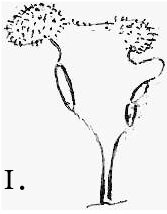
|
1. A single stamen modified; connectivum6 much dilated; on either margin a short anthera with good pollen; at the end, well developed stigmatic papillæ. |
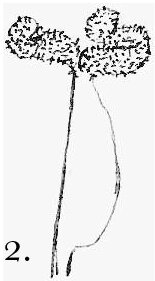
|
2. A single stamen modified; a well-developed stigma; neither anthers nor ovula. |
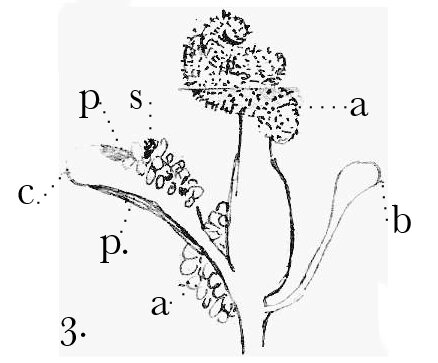
|
3. Three modified stamens, united at the base. a. well developed stigma; no pollen; numerous ovula, differing in nothing from those of the normal ♀ flowers. b. club-shaped, without pollen, ovula, and stigmatic papillæ. c. pollen on both margins of the connectivum; ovula on the convex margin; apex of the connectivum smooth, without stigmatic papillæ, but one of the ovula transformed into a stigma!— |
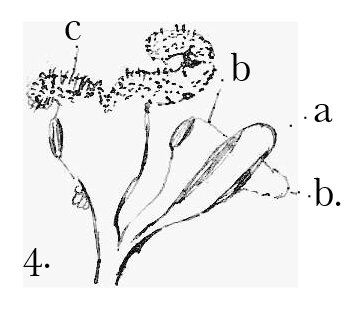
|
4. Three stamens united. a. not modified. b. connectivum much dilated; pollen on either margin; neither ovula, nor stigmatic papillæ. c. well developed stigmatic papillæ; pollen (a small quantity) on one margin alone of the much dilated connectivum a few ovula. |
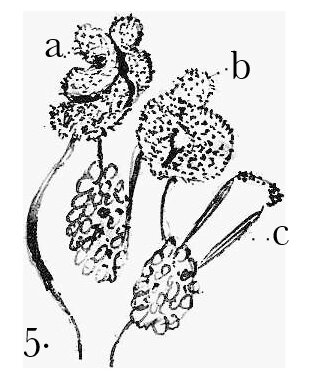
|
5. Three stamens, modified and united: a and b without pollen, with large stigmas and numerous ovula. c nearly normal, only the tip of the connectivum being somewhat enlarged and provided with small stigmatic papillæ. |
Once I saw (fig. 3, 5), in the midst of the white ovula, a dark yellow body of a club-shaped form, having nearly the size of an ovulum, covered by club-shaped papillæ exactly ressembling in shape and colour those of the stigma, so that, in this case, an ovulum appeared to have been transformed into a stigma!—
Since I have found this plant, I have been looking out for others and yesterday I have, at length, met with a second specimen (growing within 2 yards distance from the first), which promises to offer still more curious modifications. Some of the male flowers of this second plant have been transformed completely into female ones with superior perianth, but distinguished from the normal ♀ flowers by the perianth having (as in the male flowers) two large broad outer and two small narrow inner segments (whilst the female flowers have 5 segments, 1 being smaller), and by their having 4–5 stigmas and as many alæ on the ovarium (the female flowers have 3.).— In one of these abnormal female flowers there were some naked ovula between the stigmas beside those included in the ovarium.— In the first plant all the ovula of the male flowers are naked.— There are some unripe pods on the second plant, all of which are produced by normal ♀ flowers; as soon as they are ripe, I shall send you seeds of this second plant also.
There is now flowering in my garden a Salvia, almost all the flowers of which are visited by large humble-bees, which in order to reach the honey make a hole at the base of the corolla. [Specimen] 7 As some authors look at instinct as a force, which compels all the individuals of a species to act in the same way under the same circumstances, I was much interested by observing how differently the several humble-bees behaved. One humble-bee invariably alighted on the upper-lip and thence crawled down on the back of the corolla to the calyx, where it turned to the right hand; another always flew directly to the spot, where it had to open the tube of the corolla; a third behaved in different ways on different flowers.
Believe me, my dear Sir, | Yours very faithfully | Fritz Müller
Footnotes
Bibliography
Correspondence: The correspondence of Charles Darwin. Edited by Frederick Burkhardt et al. 29 vols to date. Cambridge: Cambridge University Press. 1985–.
Jackson, Benjamin Daydon. 1900. A glossary of botanic terms: with their description and accent. London: Duckworth & Co. Philadelphia: J. B. Lippencott Company.
Journal of researches 2d ed.: Journal of researches into the natural history and geology of the countries visited during the voyage of HMS Beagle round the world, under the command of Capt. FitzRoy RN. 2d edition, corrected, with additions. By Charles Darwin. London: John Murray. 1845.
Variation: The variation of animals and plants under domestication. By Charles Darwin. 2 vols. London: John Murray. 1868.
Summary
Describes experiments with sterility in Abutilon.
Describes hermaphroditism in a wild Begonia in Brazil.
Has been observing humble bees on Salvia.
Letter details
- Letter no.
- DCP-LETT-6662F
- From
- Johann Friedrich Theodor (Fritz) Müller
- To
- Charles Robert Darwin
- Sent from
- Itajahy, Santa Catharina, Brazil
- Source of text
- Linnean Society of London (SP 859)
- Physical description
- ALS 4pp
Please cite as
Darwin Correspondence Project, “Letter no. 6662F,” accessed on 20 April 2024, https://www.darwinproject.ac.uk/letter/?docId=letters/DCP-LETT-6662F.xml
Also published in The Correspondence of Charles Darwin, vol. 17


